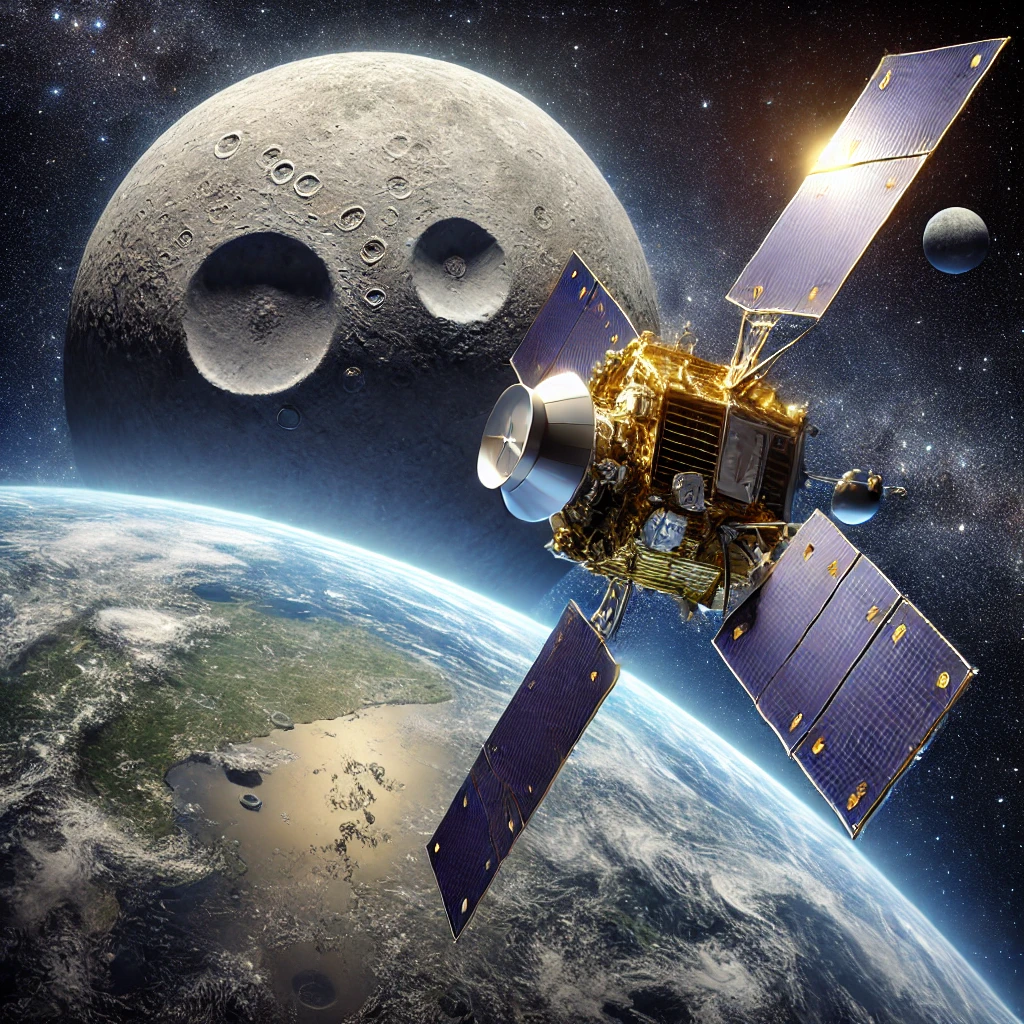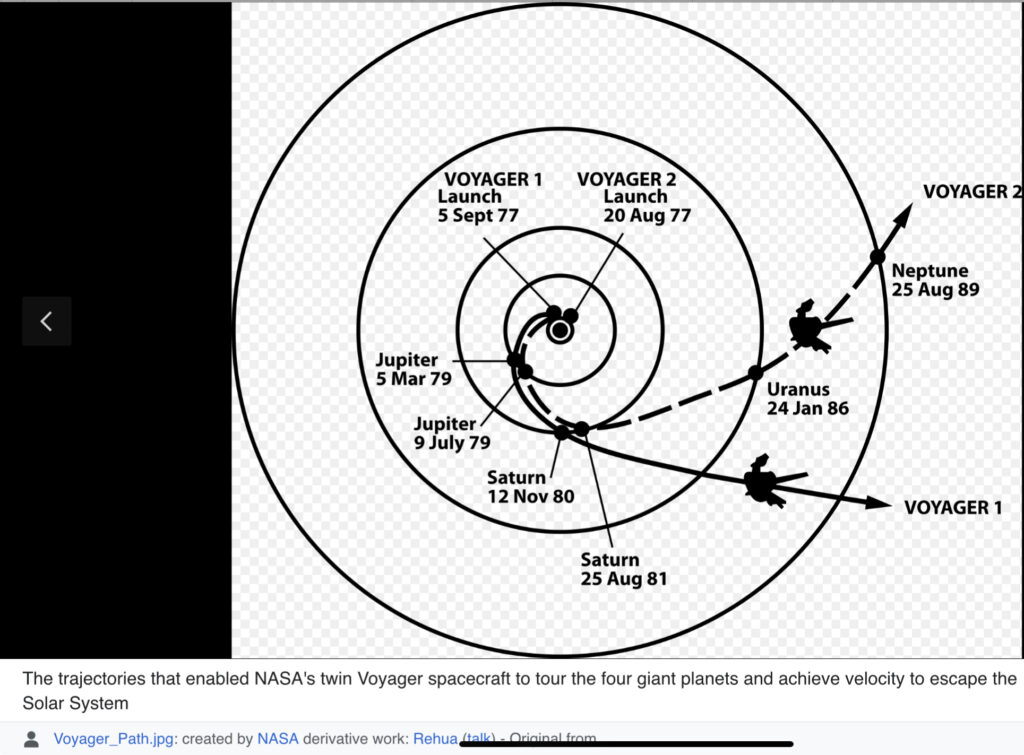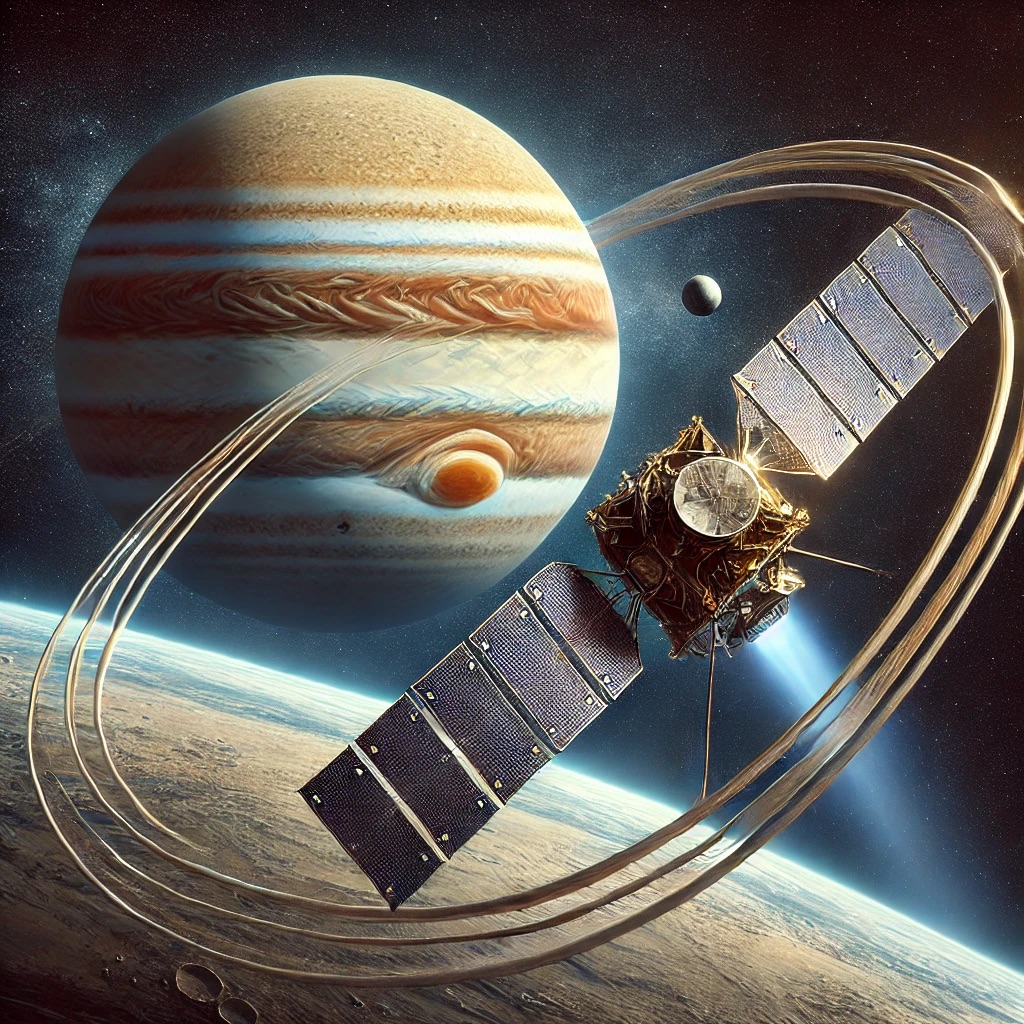ChatGPT:
🚀 Juice Probe’s Journey to Jupiter: An In-Depth Summary
The European Space Agency’s (ESA) Juice probe is on a groundbreaking mission to study Jupiter and its icy moons—Ganymede, Callisto, and Europa. Launched in April 2023, Juice is scheduled to reach Jupiter by 2031, after a series of complex maneuvers that will allow it to reach its destination efficiently. A recent and crucial phase of its journey involved an unprecedented double flyby of the Moon and Earth, which occurred in August 2024. This detailed summary explores the mission’s objectives, the intricacies of the double flyby, the challenges faced by mission engineers, and the significance of Juice’s future work around Jupiter.
🚀 Mission Overview: Juice’s Ambitious Goal
🌌 Studying Jupiter’s Moons
The primary objective of the Juice mission is to investigate the potential habitability of three of Jupiter’s largest moons: Ganymede, Callisto, and Europa. These moons are of particular interest because they are believed to harbor oceans beneath their icy surfaces. Understanding the composition and behavior of these subsurface oceans could provide valuable insights into the potential for life beyond Earth.
📅 Timeline and Launch
Juice was launched from Kourou, French Guiana, aboard an Ariane 5 space launch vehicle on April 14, 2023. The mission is part of ESA’s Cosmic Vision program, aimed at answering fundamental questions about the Solar System and the Universe. Juice’s journey to Jupiter is long and intricate, involving multiple flybys of Earth and Venus to gain the necessary speed and trajectory corrections through gravitational assists.
🌑 The Double Flyby: A Cosmic Dance
🛰️ The Need for a Complex Trajectory
While the Ariane 5 launch vehicle is powerful, it was not capable of sending Juice directly to Jupiter. Instead, mission analysts at ESA devised a highly complex trajectory involving gravitational assists. These assists, also known as slingshots, use the gravity of planets and moons to change the speed and direction of a spacecraft without expending large amounts of fuel.
🌕 Moon-Earth Flyby: An Unprecedented Maneuver
On August 19 and 20, 2024, Juice executed a highly coordinated double flyby, first passing close to the Moon and then Earth. This marked the first time in space exploration history that a spacecraft has attempted a double assist involving both the Moon and Earth in such close succession. The Moon flyby occurred at an altitude of just 800 kilometers, straightening Juice’s trajectory for the subsequent Earth flyby, which took place at an altitude of 6,800 kilometers.
🎯 Fine-Tuning the Path
This double flyby was crucial for setting Juice on the right path toward its next major milestone: a flyby of Venus in 2025. The Moon and Earth assists allowed Juice to make a sharp 90-degree turn, akin to a golf ball skirting the edge of a hole, setting it on course for its future encounters. This maneuver not only optimized Juice’s trajectory but also minimized the fuel needed for the rest of the journey.
🛠️ Challenges and Risks
🎛️ Precision and Calibration
One of the major challenges faced by the mission team was the need for extreme precision in navigating the double flyby. As Giulio Pinzan, Juice’s operations engineer, noted, any errors in the trajectory between the Moon and Earth flybys would have been amplified significantly, leading to costly fuel corrections. For instance, a minor adjustment made in late July 2024 involved a push of just 3.8 centimeters per second. If this correction had been delayed until after the double flyby, it would have required a much larger and fuel-intensive adjustment of 100 meters per second.
🚀 Avoiding Collisions
Passing close to Earth posed additional risks, particularly the potential for collisions with geostationary satellites or space debris at altitudes around 36,000 kilometers. To mitigate this risk, ESA engineers meticulously planned Juice’s trajectory, scanning for potential hazards and ensuring the safety of the probe and its large solar panels, which cover an area of 85 square meters.
🔍 Instrument Testing and Calibration
Another key aspect of the double flyby was the opportunity it provided for testing and calibrating Juice’s scientific instruments. Since the Moon lacks an atmosphere, it served as an ideal testbed for the instruments, which will later be used to study the icy moons of Jupiter. This testing phase is critical because once Juice arrives at Jupiter, there will be little time to perform further calibrations. The mission schedule is extremely tight, with 35 planned flybys of Jupiter’s moons between July 2031 and November 2034.
🧪 Scientific and Historical Significance
🌕 The Moon as a Testing Ground
The Moon played a crucial role in this phase of the mission, acting as a proxy for the conditions Juice will encounter around Jupiter’s moons. This flyby allowed scientists to conduct real-time tests that are impossible to replicate in laboratory conditions. For example, the radar system on Juice was tested against the Moon’s surface, providing data that will be invaluable for interpreting radar readings taken from the icy surfaces of Ganymede, Callisto, and Europa.
🌍 Earth’s Role in the Mission
The Earth flyby not only provided a gravity assist but also allowed for further calibration and testing of the probe’s instruments. The close approach to Earth enabled scientists to gather data on how the instruments respond in the near-Earth environment, which, while different from Jupiter’s system, still offers valuable insights.
🌟 Preparing for Jupiter
The ultimate goal of these tests and calibrations is to ensure that Juice’s instruments are fully operational by the time it reaches Jupiter. The mission timeline is unforgiving, with no room for delays once Juice arrives in the Jovian system. The intense schedule of flybys will require the probe’s systems to be in perfect working order from the moment it enters Jupiter’s orbit.
🔮 The Road Ahead: Juice’s Future at Jupiter
🚀 The Long Journey
After the successful Moon-Earth flyby, Juice will continue its journey toward Jupiter, with a planned flyby of Venus in 2025, followed by two more Earth flybys in 2026 and 2029. These assists will gradually increase the probe’s speed and adjust its trajectory for the final approach to Jupiter.
🌑 Exploring Jupiter’s Moons
Once at Jupiter, Juice will embark on an ambitious campaign to explore its moons. The probe is scheduled to conduct 35 flybys of Ganymede, Callisto, and Europa, gathering data on their ice-covered oceans, magnetic fields, and geological activity. This information could provide clues about the potential for life in these alien oceans, a question that has fascinated scientists for decades.
🛰️ Historic Orbit Around Ganymede
In a historic first, Juice will become the first spacecraft to orbit a moon other than Earth’s. The target of this groundbreaking mission is Ganymede, the largest of Jupiter’s moons and the only one with a magnetic field. Orbiting Ganymede will allow Juice to conduct detailed studies of its surface and subsurface, providing unprecedented insights into this enigmatic world.
🏆 Conclusion
The Juice mission represents one of the most ambitious undertakings in the history of space exploration. The successful execution of the Moon-Earth double flyby marks a critical milestone in the mission, demonstrating the ingenuity and precision of ESA’s mission planners. As Juice continues its journey toward Jupiter, it carries the hopes of scientists eager to unlock the secrets of the Solar System’s largest planet and its intriguing moons. The data gathered by Juice could reshape our understanding of these distant worlds and their potential to harbor life, making this mission a landmark in the quest to explore our cosmic neighborhood.

Q&A
Q: What is the main objective of the Juice mission?
A: The main objective of the Juice mission is to study the habitability of Jupiter’s largest moons—Ganymede, Callisto, and Europa—which are believed to have oceans beneath their icy surfaces.
Q: Why did Juice need to perform a double flyby of the Moon and Earth?
A: Juice performed a double flyby to optimize its trajectory towards Jupiter. This maneuver took advantage of the gravitational assists from both the Moon and Earth to adjust its path, saving significant amounts of fuel.
Q: What challenges were associated with the Moon-Earth double flyby?
A: The challenges included the need for extreme precision in navigating the flyby, as any errors would require costly fuel corrections. Additionally, there was a risk of collision with geostationary satellites and space debris when passing close to Earth.
Q: How did the ESA ensure Juice’s safety during the Earth flyby?
A: The ESA meticulously planned Juice’s trajectory and scanned for potential hazards, such as satellites and space debris, to avoid collisions and protect the probe and its solar panels.
Q: What role did the Moon play in testing Juice’s instruments?
A: The Moon served as a proxy for the conditions Juice will encounter around Jupiter’s moons, allowing scientists to conduct real-time tests and calibrations of the probe’s instruments in a relevant space environment.
Q: What is the significance of Juice becoming the first probe to orbit Ganymede?
A: Orbiting Ganymede is significant because it will allow Juice to conduct detailed studies of this moon’s surface and subsurface, potentially revealing new insights about its magnetic field, geological activity, and the presence of subsurface oceans.
Q: How will the data collected by Juice contribute to our understanding of Jupiter’s moons?
A: The data will provide detailed information about the moons’ ice-covered oceans, magnetic fields, and geological activity, helping scientists understand their potential for habitability and reshaping our knowledge of these distant worlds.
Q: What are the key milestones in Juice’s journey after the double flyby?
A: After the double flyby, Juice will fly by Venus in 2025 and then perform two more Earth flybys in 2026 and 2029. These maneuvers will set it on the final approach to Jupiter, where it will begin its exploration of the moons in 2031.
Q: How critical is the calibration of Juice’s instruments during the mission?
A: Calibration is crucial because once Juice reaches Jupiter, there will be little time for further adjustments. The instruments need to be fully operational to handle the intense schedule of flybys and data collection.
Q: What makes the Juice mission a landmark in space exploration?
A: The Juice mission is a landmark due to its ambitious goals, including the first double Moon-Earth flyby and the first probe to orbit a moon other than Earth’s. It aims to gather unprecedented data on Jupiter’s moons, which could significantly advance our understanding of the Solar System.
The European Space Agency’s (ESA) Juice probe, launched in April 2023, is on a long journey to Jupiter, which it will reach in 2031. To optimize its trajectory and save fuel, Juice is utilizing gravitational assists, a technique that uses the gravitational pull of celestial bodies to alter its path. On August 19, 2024, Juice performed an unprecedented double flyby of the Moon and Earth, using their combined gravitational forces to redirect its trajectory toward Venus, with further assists planned in 2026 and 2029.
This marks the first time such a double assist has been attempted in space exploration. The Moon-Earth flyby was carefully planned to avoid risks, such as collisions with satellites or space debris, and to ensure Juice remains on its intended course without significant corrections. This maneuver also allows ESA scientists to test and calibrate Juice’s instruments in conditions similar to those it will encounter around Jupiter’s moons. The mission’s ultimate goal is to study the habitability of three of Jupiter’s large moons—Ganymede, Callisto, and Europa—between 2031 and 2034.
Achieving a double gravitational assist maneuver involves a combination of precise calculations, advanced engineering, and deep knowledge in several scientific fields. Here’s an overview of how it’s done and the disciplines involved:
1. Orbital Mechanics (Celestial Mechanics)
- Principle: Orbital mechanics is the fundamental science that deals with the motion of objects in space under the influence of gravity. It involves calculating the trajectories of spacecraft as they move around planets and other celestial bodies.
- Application: Scientists use Kepler’s laws of planetary motion, Newton’s law of gravitation, and the equations of motion to predict and plan the spacecraft’s trajectory. They calculate how the gravity of each celestial body (like the Moon and Earth) will affect the spacecraft’s speed and direction.
2. Astrodynamics
- Principle: Astrodynamics focuses on the practical application of orbital mechanics to the design and control of space missions. It involves the precise planning and execution of spacecraft trajectories.
- Application: Mission analysts and navigators use astrodynamics to design the flight path of the spacecraft, including the timing, altitude, and angle of approach for the gravitational assists. They must ensure that the spacecraft passes by the celestial bodies at the right distance and angle to achieve the desired changes in speed and direction.
3. Computer Science and Simulation
- Principle: Complex computer algorithms and simulations are used to model and predict the spacecraft’s behavior during the flyby maneuvers.
- Application: Supercomputers run detailed simulations of the gravitational assist to account for various factors such as gravitational forces, spacecraft velocity, and potential perturbations (like slight changes in trajectory due to unexpected influences). These simulations help refine the mission plan and ensure accuracy.
4. Control Systems Engineering
- Principle: Control systems engineering involves designing and managing the systems that control the spacecraft’s orientation, speed, and trajectory.
- Application: The spacecraft is equipped with thrusters and attitude control systems that make fine adjustments to its path. Engineers use these systems to make minor corrections as the spacecraft approaches the celestial bodies, ensuring it remains on the intended trajectory.
5. Physics
- Principle: Basic principles of physics, particularly classical mechanics and gravitation, are fundamental to understanding how gravitational assists work.
- Application: Physicists contribute to understanding how forces act on the spacecraft during the maneuver and how the transfer of momentum occurs between the spacecraft and the celestial bodies.
6. Mathematics
- Principle: Mathematics is integral to all aspects of the mission, from the initial trajectory calculations to the ongoing adjustments during the mission.
- Application: Advanced mathematics, including differential equations, vector calculus, and linear algebra, are used to model and solve the complex equations governing the spacecraft’s motion.
7. Astronomy and Planetary Science
- Principle: Knowledge of the characteristics of the celestial bodies involved, such as their masses, orbits, and gravitational fields, is crucial.
- Application: Astronomers and planetary scientists provide the necessary data about the celestial bodies that the spacecraft will encounter. This includes information on their positions, gravitational strengths, and any potential hazards (like space debris or variations in the gravitational field).
8. Spacecraft Engineering
- Principle: Spacecraft engineering involves the design and construction of the spacecraft itself, ensuring it can survive and operate during the mission.
- Application: Engineers design the spacecraft’s structure, propulsion systems, and navigation systems to withstand the stresses of gravitational assists and to make the necessary course adjustments. They also ensure that the spacecraft’s instruments can be calibrated and tested during the flybys.
Summary
The successful execution of a double gravitational assist maneuver is a multidisciplinary effort that combines principles from orbital mechanics, astrodynamics, physics, engineering, computer science, and more. It requires precise planning, advanced technology, and a deep understanding of how natural forces can be harnessed to achieve the mission’s goals.

Kepler’s laws of planetary motion are three fundamental principles that describe the motion of planets around the Sun. These laws were formulated by the German astronomer Johannes Kepler in the early 17th century, based on the precise observational data collected by Tycho Brahe. Kepler’s laws revolutionized our understanding of the solar system and laid the groundwork for Newton’s theory of gravitation. Here’s a summary of each of the three laws:
1. Kepler’s First Law: The Law of Ellipses
- Statement: “The orbit of every planet is an ellipse with the Sun at one of the two foci.”
- Explanation: Planets do not orbit the Sun in perfect circles but rather in elliptical (oval-shaped) paths. An ellipse has two focal points (foci), and in the case of a planetary orbit, the Sun occupies one of these foci. The other focus is empty. This means that the distance between a planet and the Sun changes as the planet moves along its orbit.
2. Kepler’s Second Law: The Law of Equal Areas
- Statement: “A line segment joining a planet and the Sun sweeps out equal areas during equal intervals of time.”
- Explanation: As a planet orbits the Sun, an imaginary line (often called the radius vector) drawn from the planet to the Sun covers equal areas in equal periods of time. This law implies that a planet moves faster when it is closer to the Sun (at its perihelion) and slower when it is farther from the Sun (at its aphelion). The varying speed ensures that the area swept out by the line over a given time remains constant.
3. Kepler’s Third Law: The Law of Harmonies
- Statement: “The square of the orbital period of a planet is directly proportional to the cube of the semi-major axis of its orbit.”
- Mathematical Form: ( T^2 \propto a^3 ) or ( \frac{T^2}{a^3} = \text{constant} )
- Explanation: This law relates the time a planet takes to complete one orbit around the Sun (its orbital period, (T)) to the size of its orbit (specifically, the semi-major axis, (a), which is half the longest diameter of the elliptical orbit). The law states that the square of the orbital period is proportional to the cube of the semi-major axis. This means that planets farther from the Sun have longer orbital periods, and the relationship between the period and the distance from the Sun is consistent across all planets.
Summary
Kepler’s laws describe the motion of planets in a way that was more accurate than the earlier geocentric models, which placed Earth at the center of the universe. These laws showed that planetary orbits are elliptical, that planets move at varying speeds depending on their distance from the Sun, and that there is a mathematical relationship between a planet’s distance from the Sun and its orbital period. These principles were crucial for the development of classical mechanics and our modern understanding of celestial motion.

